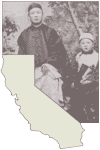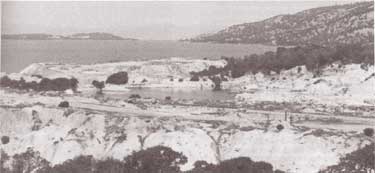![]()

Five Views: An Ethnic Historic Site Survey for California
MENU
Introduction
Early Contacts
1850s
1860s
1870s
1880s
1890s
1900s
Historic Sites
Selected References

A History of Chinese Americans in California:
HISTORIC SITES
Sulphur Bank Mine
Clear Lake Oaks, Lake County
Sulphur Bank Mine is located at Clear Lake Oaks in Lake County. Its name derives from the yellow sulphur banks that characterize the location. The mine was first worked for sulphur in 1865, and in four years produced a total of 2,000,000 pounds. It reopened in 1874 as a quicksilver mine, and became an important producer during World Wars I and II, with a total output of 92,400 flasks. Although the mine is no longer in operation, some of its buildings still stand. An aggregate block company and the Bradley Ranch are now located on the property of the Sulphur Bank Mine.
The first operations for quicksilver were conducted in 1874 by the California Borax Company, but the corporation was changed to the Sulphur Bank Quicksilver Mining Company shortly thereafter. Sulphur Banks grew to be a town of 1,000 people, due to the mining operations. Of this population, 600 were Chinese, who worked in the poisonous fumes of the furnaces and concentrators. The entire area abounded in hot springs, and it was found impossible to work at any distance below the surface. At one time, a great number of Chinese laborers were scalded to death in the big shaft when they hit a vein of boiling water, and a geyser shot up filling in the shaft. It was estimated that there were 23,184,000 pounds of quicksilver available in 1880. Up to that time, the operations had all been surface workings, but in 1881 shafts were sunk.
The number of men employed in the mine varied greatly. On the average, there were about 400 Chinese and 150 Whites. Many Whites refused to work in the bad conditions underground. The men had to wear rain suits and hats and shoes with wooden soles. Heat was so intense that the men worked in 20-minute shifts, then went to a cooling room where air was pumped from the outside. At times, the men were sprayed with water as they worked.
Once, six Chinese were in the cooling room when a landslide crushed the pipe bringing in cool air. The men were killed by heat and steam.
Two different groups of Chinese worked in the mines, and each lived at a different location. One group, whose leader was Lu Lee, had a camp garden and bunk houses half a mile north of the Sulphur Bank Rancheria on the lakeshore side of the mine. The other group had the same setup on rolling hills just south of the Indian rancheria. The head man of this latter group was Ah Van.
Only one Chinese woman was ever seen at the mines. She was called Lu and was the wife of Ah Van. She gave birth to a baby while there, but later left the place. There was considerable visiting between Chinese men and Native American women.
Chinese men lived in bunk houses about 200 feet long with a door at each end and an aisle three feet wide down the center. On either side of the aisle were rooms (eight feet by eight feet), with double-decked bunks on each side and a three-foot-wide floor space in the center. Four men shared a room. The beds had mats on them. A small scrap-iron stove, wired together, with a two-inch pipe for a chimney, was in each room. Opium was smoked generally, but in moderation.
As a result of the State Constitution adopted by California in 1879, the legislature set up conditions under which "objectionable persons" might reside in the state. One of the laws passed under this provision prohibited corporations holding state charters from employing "any Chinese or Mongolian," and established heavy penalties for violation of the law. The legislation had an immediate and paralyzing effect on the quicksilver mines, which depended almost wholly on Chinese for their underground labor. The president of the Sulphur Bank Mine, Tiburcio Parrott, deliberately defied the law so he would be arrested and tried. In the test case against him, the Circuit Court on March 22, 1880, handed down a strong opinion that held the law to be in contravention of both the Burlingame Treaty and the Fourteenth Amendment to the Constitution.
Total estimated production of quicksilver from the Sulphur Bank Mine was 127,973 flasks. At $200 per flask, production exceeded $25,000,000. The Sulphur Bank Mine was one of the most profitable quicksilver mines in the state.

Sulphur Bank Mine, Clear Lake Oaks, Lake County
NEXT> Way-Aft-Whyle
Last Modified: Wed, Nov 17 2004 10:00:00 pm PDT
http://www.cr.nps.gov/history/online_books/5views/5views3h81.htm
![]()
 Top
Top